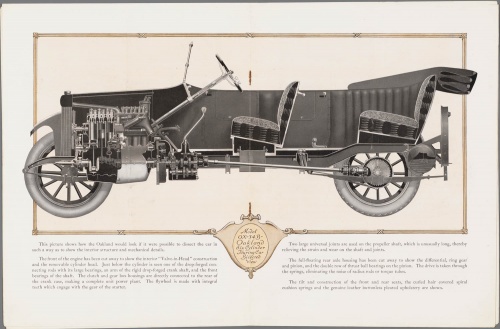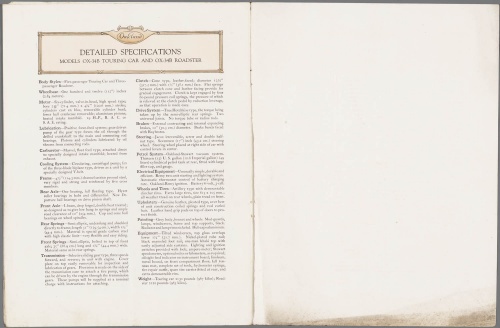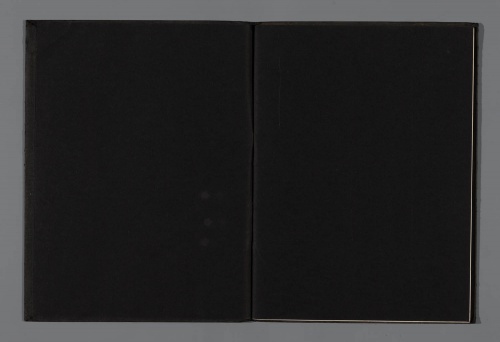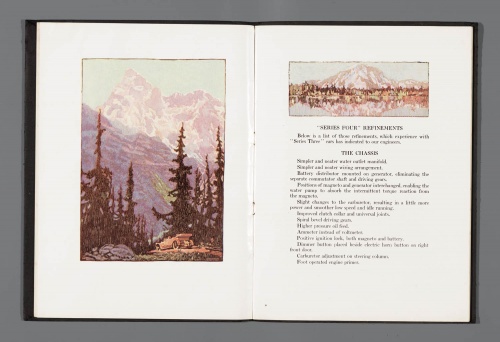Dutch Automotive History (part 52) Oakland, Pierce Arrow, Plymouth (130 photos)
OAKLAND (Pontiac, USA, 1907-1932)
The first-born of this company was the car "20NR" with a 2-cylinder engine and a planetary gearbox. In 1909, Oakland was one of the first to become part of the General Motors concern and in the same year began producing a car with a 4-cylinder engine and a conventional gearbox. In 1913, the “40HP” model was added with a 6-cylinder 6-liter engine and a wedge-shaped radiator.
In 1916, Oakland decided to gain a foothold in the class of more expensive cars. She presented a model with a V8 engine with a displacement of 5.5 liters. In the same year, the “15/29 HP Sensible Six” appeared with an overhead valve engine of 2955 cm3. The car was such a success that Oakland used all its production capacity to produce it.
At the end of 1923, the Sensible Six was replaced by the All-American Six series with a lower valve 6-cylinder engine of 3038 cm3. Features of cars in this series include an automatic lubrication system for the chassis and brakes on all wheels with external pads on the drums.
PIERCE-ARROW (Buffalo, USA, 1901-1938)
In 1900, George N. Pierce of Buffalo built a steam-powered automobile in his workshop. It was followed by a small passenger carriage with a De Dion petrol engine, designed by David Fergusson. The car was accepted by customers and began to be produced under the name “Motorette”. In 1902, Pierce released a new model with a 2-cylinder 15 hp engine, called the Arrow. Two years later, Fergusson designed a more advanced model, the Great Arrow, which looked like a Mercedes. At first it was equipped with a 4-cylinder engine with a displacement of 3770 cm3. In 1905, the Great Arrow was sold in two versions - 28/32HP and 40/45HP.
In 1909, all the company's cars acquired a new brand - "Pierce-Arrow", and the production program for this year already included three models: "36HP", "48HP" and "66HP" with 6-cylinder engines with a displacement of 5.7; 7.4 and 10.6 l. In 1913, all cars received headlights built into the front fenders, which became a distinctive feature of this company's products for many years. For five years, Pierce-Arrow produced cars without much change. Only in 1918, “38NR” and “66NR” were replaced by the new model “47NR”, the engine of which consisted of two cylinder blocks and was equipped with 4 valves per cylinder. In 1920, Pierce-Arrow was one of the last in the United States to abandon the use of right-hand steering.
In 1925, production began on a cheaper model of the "80" series, which received brakes on all wheels. Three years later, the “81” series appeared, but its unfortunate appearance had a negative impact on sales, and its production had to be stopped. Alarmed by dwindling demand, Pierce-Arrow shareholders made the difficult decision in 1929 to merge with Studebaker. There were few benefits from the reorganization. Even the new and completely perfect Silver Arrow with a V12 engine did not improve the situation. In 1933, the production car set 14 international and 65 national records while driving continuously for 24 hours at an average speed of 188 km/h. In the same year, Pierce-Arrow became independent again. Since 1934, Silver Arrows have been produced with 8- and 12-cylinder engines without significant changes, and in 1938 the company stopped producing them.
PLYMOUTH (Detroit, USA, 1928-)
In June 1928, Chrysler released an inexpensive car called the Plymouth Four, which was supposed to replace the outdated Chrysler 52 model. The new Plymouth models were very attractive from both a technical and aesthetic point of view, so the demand for them significantly exceeded the company's production capabilities. In May 1929, a second plant was opened in Detroit specifically for their production, which could produce up to 1,800 cars per day. In 1930, the Plymouth U sedan could be purchased for almost the same price as its Ford and Chevrolet classmates. However, the Plymouth was equipped with a radio receiver for an additional fee. At that time, this was an interesting novelty, because the first car radios to hit the market appeared only in 1927.
In 1931, Plymouth, under the designation "RA", introduced a completely new series, which was offered with 8 body styles, and thereby cemented its reputation as a manufacturer of modern cars for mass demand. A year later the "RV" series followed, which featured a particularly robust frame with an X-shaped cross member and an elastic engine mount. In 1933, the "P" series was offered for the first time with a 6-cylinder engine producing 70 hp. Its interesting feature is the automatic clutch, which was activated as soon as the driver took his foot off the accelerator pedal. On August 10, 1934, the millionth Plymouth rolled off the production line.
. By this event, most Plymouth models were already equipped with front independent suspension.
Unlike Chrysler and De Soto, which had a higher status in the Chrysler concern and could afford original innovations such as Airflow aerodynamic bodies, the cheaper and more mass-produced Plymouth models continued to be produced with traditionally shaped bodies, which were well received by customers. Plymouth also improved the passive safety of its models. For example, the backs of the front seats received soft padding, and safety linings appeared on the levers and handles inside the cabin.
In 1942, the Plymouth 14C series was introduced with increased interior volume and automatic inclusion of interior lighting when the doors are opened. Its development was the post-war car "15S", which served as the basis for all cars produced until 1949. In 1949, Plymouth demonstrated three new models at once: “P-17 de Luxe”, “P-18” and “P-18 Special De Luxe”, equipped with 6-cylinder lower valve engines. engines with a working volume of 3569 cm3.
The Plymouths of the early 50s were quite advanced, but they had very mediocre and inexpressive bodies installed on them. As a result, in terms of sales volume, Plymouth lost its traditional (after Chevrolet and Ford) third place in the US market to Buick. Concerned about the drop in demand, the management of the Chrysler concern decided to urgently update the body design of all models. Chrysler's chief stylist, Virgil Exner, together with the Italian coachbuilder Ghia, designed several experimental futuristic-style models for the Chrysler, De Soto and Plymouth divisions. The proven promising stylistic solutions were already used in production cars of 1955, which received longer and lower bodies.For the first time in the history of Plymouth, cars were equipped with V8 engines with a displacement of 4261 cm3, although until the end of the 60s the old lower-valve 6-cylinder engine was produced.
Only in 1957, Plymouth, having released the popular Flight Sweep series, developed by Exner, was able to again take third place in terms of sales in the American market. In the shape of the new bodies, the influence of the Tia concept cars of two years ago was clearly felt. Compared to other models, they had an increased glass area, fewer chrome decorative trims and rear stabilizers. The most interesting sports style model, the Fury, was equipped as standard V8 engine with a displacement of 5211 cm3 and a power of 218 hp, which allowed it to accelerate from zero to 100 km/h in 13.5 seconds and reach speeds of up to 160 km/h. In addition, it received a new front independent torsion bar suspension.
Exner's excellent coachwork was undermined by mediocre workmanship, so in 1958, despite the introduction of a new model with a 5.9-liter V8 engine, sales were down 50% from the previous year. Models introduced in 1960 had monocoque bodies. On the compact Valiant of 1961 with a 6-cylinder engine with a displacement of 3687 cm3, the rear stabilizers disappeared, and the next year all Plymouths acquired calmer and smoother shapes. Despite the popularity and high quality of the Valiant, Plymouth this time was forced to settle for fourth place in terms of sales, behind the Rambler models of the American Motors concern. In 1962, the last models designed by Exner for Plymouth appeared on the market: Belvedere, Fury-G, Fury-I, Fury-SH and Satellit.
In 1964, a sporty model, the Barracuda, was released with a body that had a sloping rear roof that merged into the trunk lid. After 3 years, its design was significantly changed. The machine was equipped with an inclined 6-cylinder engine with a displacement of 3687 cm3. In 1967, the Plymouth program consisted of 38 models, which were offered with a large number of engine and body styles. In the families of models of the so-called intermediate class “Satellite” and “Belvedere”, sports modifications “GTX” and “Road Runner” appeared, which could be equipped with 7.2- and 7.0-liter V8 engines with a power of 395 and 430 hp
In 1970, the Belvedere series was completely replaced by the updated Satellite models. The top of the range next year was the Sport Fury with luxurious interior trim. In 1975, two years after the oil crisis, the outdated and rather “gluttonous” cars Road Runner, Satellite and Barracuda had to be excluded from the program, but the Fury continued to be offered in three versions. The crisis gave birth to a more economical and compact version of the Valiant. Soon the new Volare replaced almost all Fury models, except for the most prestigious Grand Fury. The mid-size Volar with a sedan body appeared in 1976. Since 1977 it has been offered with
6- and 8-cylinder engines with a displacement of 3.7-5.9 liters and a power of 101-157 hp.
In the late 70s and early 80s, not a trace remained of the former power of the Plymouth models. Since 1978, a small front-wheel drive model “Horizon” appeared with a 1.7-liter engine producing 70 hp, which was an Americanized version of the French SIMCA-Chrysler Horizon. Four years later, the sports model Turismo was created on the Horizon chassis.
In 1980, a new generation of compact and also front-wheel drive Reliant models appeared, developed by Chrysler. They were distinguished by small 2-, 4- and 5-door bodies with a length of 4.48 m and 4-cylinder engines of 2.2 and 2.6 liters with a power of 97 and 102 hp. The only relatively large car in the early 80s was the Gran Fury, which had a sedan body 5.23 m long. But in 1984, the power of its 5.2-liter V8 engine was only 132 hp.
For Plymouth, the 80s marked the beginning of a new era. Compact and economical models have appeared. In 1986, a slightly smaller family of Sundance models was shown than the Rylant. 1989 was marked by the release of the sports “Lazer”, which was assembled at the American plant of the Mitsubishi company, the same type as the “Eclipce” and “Acclaim” models developed by Chrysler. However, the most interesting event of the 80s was the appearance of the first and very popular American high-capacity station wagon (minivan) of the Vogager family, similar to the Dodge Caravan.
In the 90s, the Plymouth brand gradually lost its position in the American market to the more prestigious Dodge models, of which 3.5 times more were produced in 1997 than Plymouths. Over 8 years (from 1990 to 1997), the range of Plymouth models was reduced from 7 to 3 families. This is not least due to the fact that the Chrysler concern, following consumer demand, reoriented itself to the production of so-called light trucks, the share of which, for example, by the end of 1997 exceeded 70% of the total production of all cars.
In 1998, the Plymouth program included the small 2- and 4-door Neon model, the slightly larger Breeze and the already famous Voyager. "Neon" and "Breeze" are equipped with 2-liter 4-cylinder engines with a capacity of 133-152 hp, and Voyager is equipped with 4- and 6-cylinder engines with a capacity of 2.4-3.8 liters and a power of 152-182 hp.































